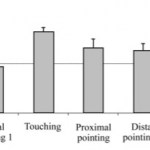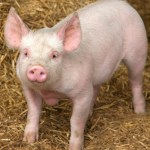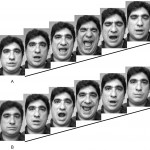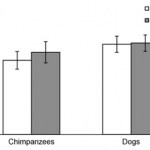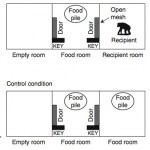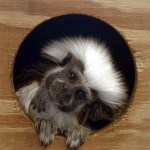Comparative Psychology
For today's dose of monday pet blogging, head on over to a piece that I wrote for Scientific American that went up today. I used the invitation as an opportunity to a dig a little deeper into the story of Belyaev and his domesticated silver foxes (I previously wrote about them, here and here)
Dogs are pretty smart. They can have huge vocabularies, they can infer meaning in the growls of other dogs, and they can effortlessly figure out if other dogs want to play or fight with them. But their intelligence might be limited to the social domain; indeed, while they outperform chimpanzees in social tasks, chimpanzees outperform them in many other tasks. And they might have developed their impressive social skills as merely an accident of natural and artificial selection.
Previous research has shown that dogs can use lots of different forms of human communicative signals to find food,…
Earlier this week I wrote about the developmental and evolutionary origins of large number representation. A series of studies in human infants, monkeys, rats, and fish demonstrated that animals and humans spontaneously represent large (>4), abstract, approximate numerosities. Animals, human infants, and human adults, show the same ratio signatures (based on Weber's Law). Adult tamarins are on par with 9-month-old human infants. With age or training, discriminability becomes more precise, and the the critical ratio is reduced a bit. There is good evidence that the large number…
Late last week you might have seen headlines that went something like this:
"Pampered pigs 'feel optimistic'"
or, this: "Can you ask a pig if his glass is half full?"
or, "Pigs have feelings, too (and they prefer a bit of luxury)"
The headlines came, respectively, from BBC News, EurekAlert, and the Daily Mail.
This sounded pretty fishy to me. Optimism or pessimism requires a certain amount of introspection and future awareness. Without a meaningful sense of the future, optimism doesn't mean very much. I don't know much about cognition in pigs (and, for that matter, there hasn't been a ton of…
It's been a pretty long stressful week around here, and not just because of Pepsipocalypse and the resulting fallout. But, well, I'm back, and I have an awesome paper to tell you about. When I saw it I just KNEW it had to be blogged.
Mythbuster Adam Savage sets the yawning in motion in Mythbusters attempts to start a yawning epidemic across the globe
Did watching that video make you yawn? Chances are it did, and you can thank contagious yawning for it. What is contagious yawning? Contagious yawning is a very well-dcoumented phonemenon wherein yawning is triggered by the perception of others…
Dogs are particularly good at tasks that involve communicating or cooperating with humans, which has led some researchers to speculate that they are really good at solving social tasks, more generally. For example, dogs can figure out where a human's attention is, are really good at picking up on eye-gaze and finger pointing cues, distinguish among different individual humans (by contrast, humans are really bad at distinguishing among different individual monkeys, for example), and at least in one outstanding case, are capable of "fast mapping."
Relative to non-human primates, domestic dogs…
Evolutionary Psychology suffers from a PR problem, which can be mostly blamed on ignorant (even if well-intentioned) members of the population who don't know what they're talking about.
Evolutionary psychology attempts to describe the evolution of the mind and of behavior and, well, everyone has a mind, and everyone can observe behavior. This makes people think that they are experts. Anybody who has ever had a child knows everything there is to know about child development. Anybody who has ever owned a dog becomes an expert on canine behavior. Study after study demonstrates the fact that…
Bonobo Week continues! I'm donating whatever proceeds I receive from my blogging shenanigans for the entire month of June to help the bonobos at Lola Ya Bonobo.
Imagine that you're wandering in the desert and you come across two magic lamps. One lamp grants three wishes. It's your standard sort of magic lamp with a genie in it. (No wishing for extra wishes, of course.) The second magic lamp is, well, a moody magic lamp. It's inconsistent. Sometimes it grants one wish, and sometimes it grants seven wishes. But the thing is, you don't know for sure whether, when you rub the lamp and genie pops…
Bonobo Week continues! I'm donating whatever proceeds I receive from my blogging shenanigans for the entire month of June to help the bonobos at Lola Ya Bonobo.
Primate researchers used to think that only humans voluntarily share their own food with others. At the time, it was a reasonable conclusion to make, since lots of studies indicated that chimps don't. But that was before anyone checked to see if bonobos were willing to share their food with others.
So Brian Hare and Suzy Kwetuenda tested pairs of the bonobos from the Lola Ya Bonobo sanctuary in DRC. In all cases, the two…
Yesterday afternoon, I watched the livestream of the "All Creatures Great and Smart" session of the World Science Festival in New York City. The session was absolutely fantastic, and featured Brian Hare, Vanessa Woods, Jeremy Niven, Patrick Hof and Klaus Zuberbühler.
The conversation challenged long-held assumptions about the differences between "animal" and "human", and included fascinating discussion about pin-sized brains that can count, categorize, and hold a grudge against those who've tried to swat them. Does your dog really think and feel like a human? Do our closest primate…
The perspective that whales, dolphins, and other such marine mammals should be afforded "human rights" has surfaced again.
I thought I'd revisit a post I wrote about this several months ago, from the archives, when this first hit the news after the AAAS conference in San Diego. So here's a modified, updated version of the original post.
The blogosphere is all a-twitter with talk of the recent commentary in Science that dolphins should be considered people. Well, sort of people. Non-human people.
On the heels of the incident at SeaWorld in Florida in which a trainer was killed by one of the…
...and what can word-learning in dogs teach us about the evolution of language in humans?
What is involved in the learning of a single new word? Consider the word "tiger", being learned by a child with already a modest vocabulary, at least for animal words. First the child must make a new entry in the mental lexicon - that "tiger" is a word in the first place. He has to categorize it as a noun. It has to be categorized under "animal" (a supernym) and related to its hyponyms, like "Sumatran tiger." Then, of course, the child has to learn what actual *thing* the word "tiger" refers to. Now,…
Let me tell you a little story. When I was born my parents had two cats. One was named Garfield. The other...well, I don't remember what the other one was called. Not long after I was born, and little Jason was coughing up furballs, the doctors informed the parents that their little bundle of skin and hair was allergic to cats. It was then that teams were picked and lines were drawn. It was me or the cats. Luckily, the parents decided to keep me, and lose the cats. Imagine how much it would have sucked if they decided to keep the cats and lose me. I imagine if my younger brother had actually…
What are the cognitive and neural systems that allow us to build buildings, play checkers, do multivariate statistics, receive DVDs by mail, follow Dr. Isis's pesto recipe, or navigate the tangled LA freeways?
You may ask: what can studying children and non-human animals tell us about the complexity of the human experience? Only educated human adults engage with formal mathematics, cooking, or map reading. Right?
This is a reasonable question to ask. But when human adults show complex, possibly culture-specific skills, they emerge from a set of psychological (and thus neural) mechanisms…
In an update to their groundbreaking earlier demonstration that high-IQ children initially show a thinner cortex, and later show an initially thicker one than their average-IQ peers, Shaw et al. have now documented those trajectories of cortical thickening which are invariant to socio-economic status and IQ, but vary between regions of the brain. These videos show the peak in gray matter in cortex between the ages of 5 and 15 years, as assessed from magnetic resonance imaging (MRI) of 375 subjects of varying ages.
And another video below the fold...
Dark red areas indicate those…
In their already-classic 2001 article, Miller & Cohen use a "train track" metaphor to illustrate the function of prefrontal cortex. The idea is that myriad learned associations interconnect sensory representations with motor commands (metaphorically, these are the "train tracks"). The important associations will change depending on the animal's current task (these are the "switching stations" which allow crossover between the train tracks). Thus, the role of prefrontal cortex is to bias activity in the brain (the "train") to undergo the sensory-motor transformations which are task- and…
Got your attention, right? That's the title of a paper by Penn, Holyoak, and Povinelli in April's Behavioral and Brain Sciences. Well, the full title is "Darwin's mistake: Explaining the discontinuity between human and nonhuman minds." Here's the abstract:
Over the last quarter century, the dominant tendency in comparative cognitive psychology has been to emphasize the similarities between human and nonhuman minds and to downplay the differences as "one of degree and not of kind" (Darwin 1871). In the present target article, we argue that Darwin was mistaken: the profound biological…
Over New Year's I had a brief discussion with a condensed-matter physicist who proclaimed that 1) "some developmental research is amazingly bad" and that 2) "they think they can tell what a baby has learned from what direction it looks," topping it all off with 3) "you guys don't even know what learning is!"
I won't argue with the first point (there are bad researchers in every field, even condensed matter physics), and I'm too lazy to bother with the third (although the 2000 Nobel prize committee might disagree), but the second point - on the technique of preferential looking - I just can't…
I've been busy as hell, so I haven't had much time or energy to post anything lately. But I had an idea today that I thought I'd try out. There are a bunch of experiments that I really like for various reasons, and because I really like them and have described them so many times, I can write ten pages about them in my sleep (and given the fact that I'm so tired, I may well be doing that by the end of this post). So I'm going to try to post on one of these every now and then until things slow down a bit here over the break. I'll try to give a bit of context and explain why I like the studies…
Several have criticized my post on handedness by pointing to evidence (or hearsay) that animals do have handedness. This evidence comes in several forms:
Anecdote: "My cat plays with its right paw"
Individual or Activity-Specific Cases: "Horses reliably pick one leg to lead their galloping" or "Chimps prefer to fish with their left hand"
Marginal asymmetry: "X chimps are right-handed for every Y left-handed chimps." [where X/Y 9]
Let's be clear: handedness in humans is immensely asymmetric (9:1) at the population level, and holds across multiple tasks within individuals (most people are…

